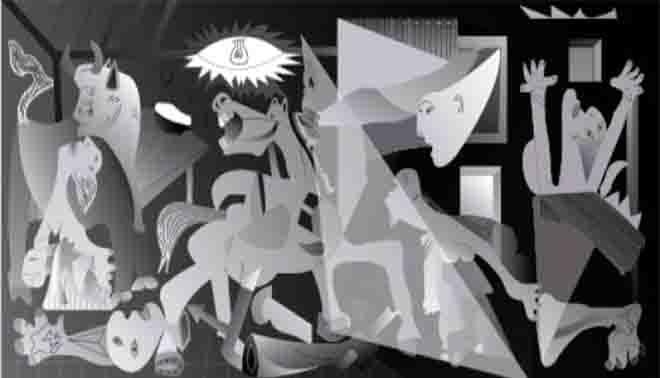Concetti Chiave
- Post-Impressionism, coined by Roger Fry in 1911, included movements like Fauvism, Cubism, and Expressionism, emphasizing the spiritual essence of subjects.
- Fauvist artists, led by Henri Matisse, were known for their vibrant colors and drew inspiration from non-Western art forms like African masks and Japanese prints.
- Post-Impressionist painters shifted focus from city life to subjects like still-lives, portraits, and landscapes, using geometric forms to capture nature's essence.
- Cubism, developed by Picasso and Braque, sought the geometrical understructure of forms, using "simultaneity" to depict multiple perspectives at once.
- Cubism was revolutionary, moving beyond Impressionism by interpreting reality with the brain, not just the retina, paralleling Einstein's challenge to Empiricism.
Post-Impressionism: origin of the name and main themes
The term Post-Impressionism was coined for the first exhibition organized in London in 1911, by the critic and painter Roger Fry (1860-1934) with the title "Monet and the Post-Impressionists". It included several artistic movements, such "fauvism" ,"cubism", "expressionism"(a term usually reserved for the German movement),"vorticism".According to the new vision of art, the artist was free to distort the form of nature, trying to reach the essentially or inner significance of his/her subject. Roger Fry fostered the artistic search for the spiritual inner meaning of a material subject, for instance, as he said, the "terseness of a tree".
In 1905 the French painter Henri Matisse (1969-1954), the leader of a new group of artists, exhibited their works in Paris at the "salon des independents". These works had such brilliant colors that third authors were called "Les Fauves"("wild beasts"). They found sources of inspiration in African masks, Persian and Indian paintings, Japanese prints, Chinese materials, such as textiles and porcelain, etc. Among the British "fauvists" are numbered Duncan Grant, and Matthew Smith, with his vigorous, almost wild colors.
Generally speaking, painters of that time did not focus on city life anymore but they decided to give a renovated importance at elements such as: still-lives, portraits and landscapes.
As a matter of fact it was believed that the essence of nature could have been caught by using basic geometrical forms.
For example Seurat’s paintings were connotated by the presence of drown close monochromatic dots and signs that were perceived united in the brain of the observer.
Detailed analysis of Cubism
Cubism is a development of Post-impressionism. Cubism consists in the search for the geometrical understructure of natural forms.This mode of painting began with the Spanish painter Pablo Picasso and the French artist Georges Braque.
The name originally was used by Matisse in 1908 to denigrate some Braque’s works defining them made by little cubes. In 1909 the critic Louis Vauxcelles named them Cubist whimsy.

Characteristic of Cubism was the device know as "simultaneity", that is the simultaneous vision of a figure from different points of view, having nothing to do with apparent reality and practical appearances, while, since the Renaissance, painters had always used a centralized technique. As a consequence prospective and the distinction between the artistic subject and the background is abolished.
It was a revolutionary act because for the first time the aim of art wanted to represent the entirety of reality going beyond the superficiality of Impressionist artists which used only their retina and not their brain.
That means that reality is not painted as it is but it is interpreted and it is considered a gnoseological instrument for the human being.
It is interesting to notice that, in the same time, Einstein was thinking about his Relativity theory and, even though the two phenomena are not related, it can be underlined that the need to outdo the Empiricism was strong.
The Cubism was divided in two faces: the analytical Cubism (1908-1912), monochromatic, dark and deeply fragmentated, and the synthetic Cubism (1912-1914) with a little bit more color and structure.

Domande da interrogazione
- Qual è l'origine del termine Post-Impressionismo e quali sono i suoi temi principali?
- Chi erano i principali esponenti del Cubismo e come è nato questo movimento?
- Quali sono le caratteristiche distintive del Cubismo?
- Come si divide il Cubismo e quali sono le sue fasi principali?
- Quali influenze culturali hanno ispirato i Fauves e come si collegano al Post-Impressionismo?
Il termine Post-Impressionismo fu coniato da Roger Fry nel 1911 per una mostra a Londra. Includeva movimenti artistici come il fauvismo, il cubismo e l'espressionismo. Gli artisti cercavano di distorcere la forma della natura per raggiungere il significato interiore del soggetto.
Il Cubismo è nato con Pablo Picasso e Georges Braque. Il termine fu inizialmente usato da Matisse nel 1908 per denigrare alcune opere di Braque, e successivamente adottato dal critico Louis Vauxcelles nel 1909.
Il Cubismo si caratterizza per la "simultaneità", ovvero la visione simultanea di una figura da diversi punti di vista, abolendo la prospettiva e la distinzione tra soggetto e sfondo. Rappresenta la realtà in modo interpretativo, superando la superficialità dell'Impressionismo.
Il Cubismo si divide in due fasi: il Cubismo analitico (1908-1912), caratterizzato da tonalità monocromatiche e frammentazione profonda, e il Cubismo sintetico (1912-1914), con più colore e struttura.
I Fauves, guidati da Henri Matisse, si ispirarono a maschere africane, pitture persiane e indiane, stampe giapponesi e materiali cinesi. Queste influenze culturali si collegano al Post-Impressionismo attraverso l'uso di colori brillanti e la ricerca di significati spirituali.







 Accedi a tutti gli appunti
Accedi a tutti gli appunti
 Tutor AI: studia meglio e in meno tempo
Tutor AI: studia meglio e in meno tempo